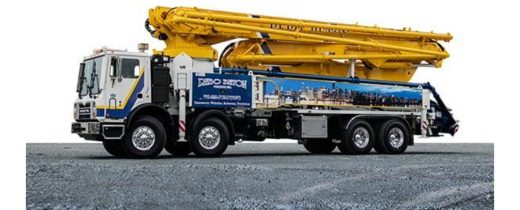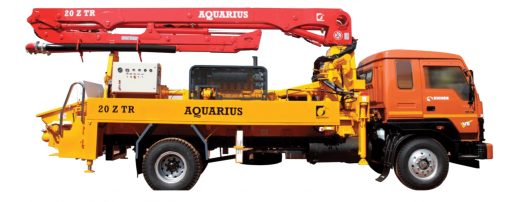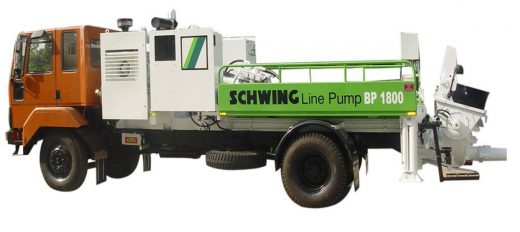What is a Concrete Pump?
A concrete pump is a machine to transport liquid concrete from storage tanks or batching plants to the worksite where it will be poured or filled. A concrete pump is a crucial piece of equipment for any construction job of significant scale. A concrete pump, which is now standard fare on every building site, is the most popular tool for transporting or transferring liquid concrete. The concrete pump has greatly accelerated construction times, particularly for tall buildings like skyscrapers.
Pouring concrete in tight or crowded spaces is made easier with the help of concrete pumps. Therefore, whether you’re placing the concrete in a footing slab or on the top floor of a skyscraper, concrete pumps can get the mixture there without leaving streaks or bubbles on the ground.
In high-rise buildings or behind protected concrete barriers, where accuracy in pouring is paramount, concrete pumps are an indispensable tool. When using a concrete pump, there is significantly less waste and greater precision in the finished product.

Fig 1: Concrete Pump
Courtesy: allianceconcretepump.com
How does a Concrete Pump Work?
With the help of concrete pumps, liquid concrete is moved from where it is mixed to where it will be used. The valves turn the pumps on and off, and hydraulics powers them.
When an abundance of concrete is required, it is first mixed in the revolving drum of a special truck. Concrete is transferred from the truck to a hopper and mixed to prevent quick hardening. The concrete pump draws the liquid concrete from the hopper and transports it to the desired placement site via a valve system and, in certain cases, auxiliary hoses.
A twin-cylinder hydraulic concrete pump has two internally parallel cylinders. Cylinders are driven in both directions by pistons located within them. Both go in opposite directions. The first cylinder, also called the material cylinder, is responsible for extracting the concrete from the hopper.
The second cylinder referred to as the “discharge cylinder,” is responsible for releasing the concrete from the pump. The pistons draw and release liquid concrete in a tandem motion. Continuous hydraulic pressure must be applied for the cylinders to move back and forth; this takes place while concrete is poured. Maintaining a continual flow is also vital to prevent cemented concrete.
A concrete pump needs a qualified operator to operate it. The pump operator controls the pump’s operation, position, and output by controlling the boom or hose. The operator’s duties include bringing the pump to the site, setting it up, operating it, breaking it down, cleaning it, and fixing it.
Types of Concrete Pumps:
1. Boom Concrete Pumps:

Fig 2: Boom Concrete Pump
Courtesy: bncinternational.co.in
Boom concrete pumps are stationary during the concrete pouring process. Since this is the case, these concrete pumps are stationary. They’re bigger and grounded, making them more noticeable. Attached to these are cranes or boom arms of varying lengths.
With the help of a boom concrete pump, concrete can be pumped to varying heights, which is especially useful when constructing a tall building. Concrete pumps with booms make it possible to raise and lower the pipe. It means these pumps can be utilized to free one from constricting situations. Concrete pumps like these make it simple to work around obstacles.
2. Line Concrete Pumps:

Fig 3: Line Concrete Pump
Courtesy: schwingstetterindia.com
These pumps are used for small-scale building projects. They are made to be small. It has a line pump hooked up to the trailer or the lack of the truck. So this set-up is also called a truck-mounted pump or a trailer concrete pump.
It needs to be hooked up to the machine outlet with a rubber or steel hose. As a boom pump, it can’t lift too much liquid concrete too high.
3. Specialized Usage Pump

Fig 4: Specialized Usage Concrete Pump
Courtesy: brighthubengineering.com
They are designed particularly for mines and tunnels and other special construction projects. There are also skid-mounted and truck-mounted concrete pumps, but they are not used as often because they are expensive and require advanced skills.
How to Choose a Concrete Pump
The concrete pump is chosen based on what the building project needs. Choosing a good and right concrete pump depends on the following factors:
i) Manufacturer of Concrete Pump:
The primary consideration should be the quality of the pump’s construction materials. Locate the most reliable concrete pump producers in your area and go with them. Seek the assistance of a local contractor and an established manufacturer to accomplish this.
ii) Purpose of Concrete Pump:
The concrete pump must be able to do the job for which it was bought. For example, if a concrete pump that was bought could not be used to fill the middle of a tunnel that was being built, then the pump had no use for the construction project. So, the contractor or person in charge of a building must ensure that the concrete pump they buy is versatile and has great functions.
iii) Price and Economic Factors:
Price is another important thing to remember when picking a concrete pump. It would be best if you chose an appropriate pump that can do its job within the price range. Don’t spend a lot on pumps with low power. Always consider both price and performance while choosing a pump.
iv) Selection of Concrete Pump based on work:
When choosing a concrete pump for a job, two main things are taken into account:
a) Pumping Pressure
b) Volumetric Concrete Output
The maximum amount of concrete that can be made per hour has been decided for the concrete work. The work or project requirements determine the pressure of the pump. This pressure is used to choose the right concrete pump. The power of the concrete pump’s driving device is determined by the pumping pressure (P) and the required rate of concrete delivery (Q). After that, you can use the following equation to figure out the hydraulic power (H):
H = Q x P
The above concrete pumps can be chosen based on the application’s needs and the construction project.
- Large road and highway projects are best built with a boom or truck-mounted concrete pump.
- A boom concrete pump is the best choice when you need to pour concrete at different heights or in a small space.
- Boom concrete pumps can install two or three robotic pump lines that work like a robot arm that can do more than one thing. It reduces the amount of employees required.
- A line concrete or stationary pump is used to build sidewalks or slabs. Wherever only a small amount of concrete needs to be pumped, the stationary pump is used.
Uses of Concrete Pump:
- It is the best way to speed up putting concrete on a construction site.
- When concrete pumps are used instead of other ways of pouring concrete, when the concrete is put in place, it won’t shrink or crack and will still be strong.
- Concrete pumps are used to make pouring more accurate in places that are hard to reach, like high-rise buildings or insulated concrete from walls.
Advantages of Concrete Pump:
- When compared to other options, using these pumps is safer.
- The concrete pumps can easily move the concrete.
- These pumps reduce the amount of work that needs to be done.
- These pumps can move concrete more quickly.
- They save money on expenses, energy use, and labor.
- They are very reliable and work very well. By using these pumps, less work is needed.
Disadvantages of Concrete Pump:
- The total price will be higher than other pumps.
- The budget for building a private house is much lower than a commercial building, so commercial buildings are best suited for this type of construction.
Conclusion:
A concrete pump is a common tool for pouring concrete. Given the growing prevalence of concrete pumping, the concrete construction sector must evolve and enhance its methods. More volume and pressure from concrete pumps are needed. Concrete, which is more rigid than other building materials, also requires elevated delivery. The manufacturers of concrete pumps and boom placers have included these specifications in their products to be utilized in a wide range of environments.
References:
1. “Concrete Pump – Wikipedia.” Concrete Pump – Wikipedia, 1 July 2014, en.wikipedia.org/wiki/Concrete_pump#:~:text=A%20common%20type%20of%20concrete,truck%20or%20a%20semi%2Dtrailer.
2 Ganbaatar, Erdenebaatar. “(DOC) Concrete Pumping History | Erdenebaatar Ganbaatar – Academia.Edu.” (DOC) Concrete Pumping History | Erdenebaatar Ganbaatar – Academia.Edu, www.academia.edu/6229496/Concrete_Pumping_History. Accessed 15 Sept. 2022.
3. “What Is Concrete Pumping and How Does It Work? | Total Concrete.” Total Concrete, 1 Mar. 2018, www.totalconcrete.co.uk/news/concrete-pumping-work.
4. Facilitator, Constro. “Different Types of Concrete Pump.” Constro Facilitator, 18 May 2022, www.constrofacilitator.com/different-types-of-concrete-pump.
5. Concrete, Intelligent. “What Is Concrete Pumping? | Intelligent Concrete.” Intelligent Concrete, 21 Feb. 2022, www.intelligent-concrete.com/what-is-concrete-pumping.
6. “Concrete Pumps Types – Applications and Advantages.” Vin Civilworld, 6 July 2021, vincivilworld.com/2021/07/06/concrete-pump-types-advantages.
7. Pumping, Foxcrete Concrete. “Choosing the Correct Concrete Pump | Foxcrete Concrete Pumping.” Foxcrete Concrete Pumping, 20 July 2016, www.concretepumping.co.za/choosing-the-correct-concrete-pump.
If you have a query, you can ask a question here.


